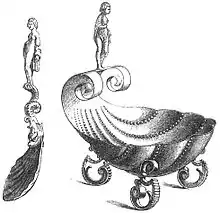Salt spoon
A salt spoon is a miniature utensil used with an open salt cellar for individual service.[1] It is a historical and nostalgic item from a time before table salt was free-flowing, as it is today. The spoon itself ranges from 2 to 3 inches (5 to 7.5 cm) long and has a circular bowl measuring approximately 0.5 to 0.75 inches (1.25 to 2 cm). They can be found in a wide range of materials including glass, Sterling silver, plastic, wood, ivory, bone and shell.

As a unit of measurement in old recipes, 1 salt spoon (ssp) = 0.25 teaspoon, or slightly more than 1 ml.[2]
Salt absorbs moisture from its surroundings, and had a tendency to clump together into one large lump. The head of the household usually presided over the distribution of salt at the dining table. This lump of salt was placed into a small dish, called by various names - open salt, salt cellar, table salt. Today we also refer to these as Master salts. It was then broken up with a knife handle or other utensil and placed into smaller, individual salt cellars, often matching the larger one in design. Since it was such a precious seasoning, only small portions were given to each person at the table. The food was either dipped into the small individual salt cellars or was scooped out with the small salt spoons and sprinkled over the food.
In the early 1930s, a process was developed which literally coats each grain of salt and keeps it from sticking together. Due to these changes in the processing of salt for consumer use, the open salt cellar and its accompanying salt spoon have become largely obsolete, having been replaced by the everyday salt shakers. They are, however, a highly collectable item and are still used today as a bit of nostalgia on many dining tables.
Notes
- http://dictionary.reference.com/browse/salt+spoon
- "Cookbook:Saltspoon". Wikibooks. Retrieved 14 July 2020.